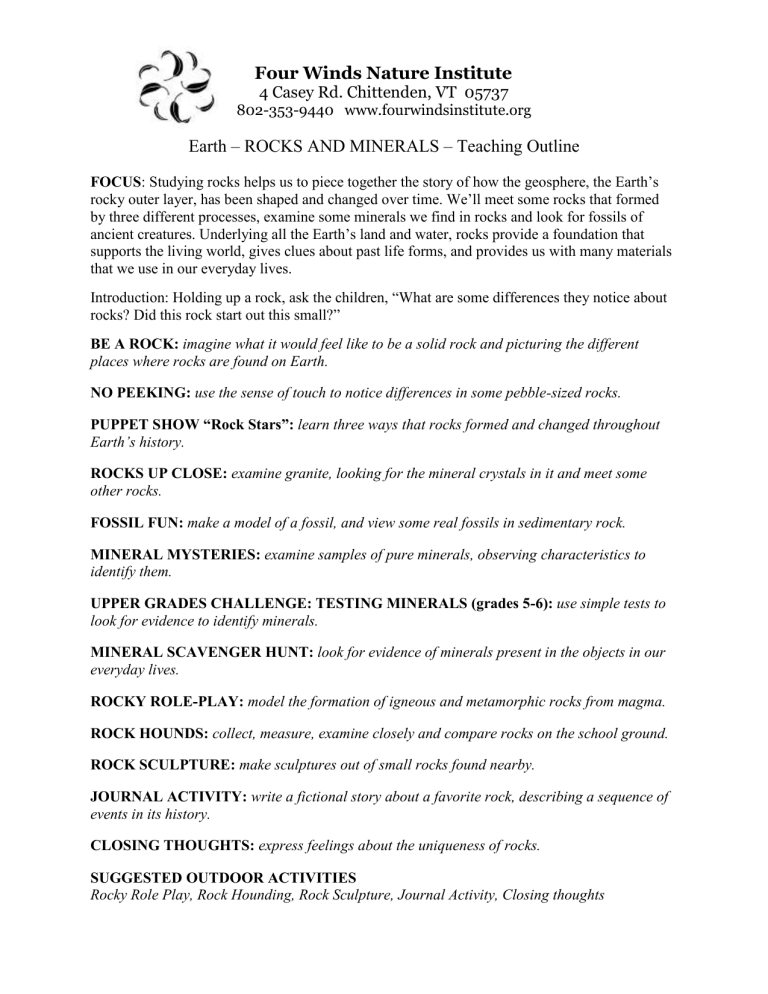HABITATS – LIFE IN A FIELD: Exposed to the Elements

Four Winds Nature Institute
4 Casey Rd. Chittenden, VT 05737
802-353-9440 www.fourwindsinstitute.org
Earth – ROCKS AND MINERALS – Teaching Outline
FOCUS : Studying rocks helps us to piece together the story of how the geosphere, the Earth’s rocky outer layer, has been shaped and changed over time. We’ll meet some rocks that formed by three different processes, examine some minerals we find in rocks and look for fossils of ancient creatures. Underlying all the Earth’s land and water, rocks provide a foundation that supports the living world, gives clues about past life forms, and provides us with many materials that we use in our everyday lives.
Introduction: Holding up a rock, ask the children, “What are some differences they notice about rocks? Did this rock start out this small?”
BE A ROCK: imagine what it would feel like to be a solid rock and picturing the different places where rocks are found on Earth.
NO PEEKING: use the sense of touch to notice differences in some pebble-sized rocks.
PUPPET SHOW “Rock Stars”: learn three ways that rocks formed and changed throughout
Earth’s history.
ROCKS UP CLOSE: examine granite, looking for the mineral crystals in it and meet some other rocks.
FOSSIL FUN: make a model of a fossil, and view some real fossils in sedimentary rock.
MINERAL MYSTERIES: examine samples of pure minerals, observing characteristics to identify them.
UPPER GRADES CHALLENGE: TESTING MINERALS (grades 5-6): use simple tests to look for evidence to identify minerals.
MINERAL SCAVENGER HUNT: look for evidence of minerals present in the objects in our everyday lives.
ROCKY ROLE-PLAY: model the formation of igneous and metamorphic rocks from magma.
ROCK HOUNDS: collect, measure, examine closely and compare rocks on the school ground.
ROCK SCULPTURE: make sculptures out of small rocks found nearby.
JOURNAL ACTIVITY: write a fictional story about a favorite rock, describing a sequence of events in its history.
CLOSING THOUGHTS: express feelings about the uniqueness of rocks.
SUGGESTED OUTDOOR ACTIVITIES
Rocky Role Play, Rock Hounding, Rock Sculpture, Journal Activity, Closing thoughts
Unit Concepts/Ideas:
A.
Since the earth’s beginning, rocks have continually been formed, changed by heat and pressure, worn away into tiny pieces, and then cemented together again by natural forces.
This endless cycle of change continues today.
B.
Rocks are grouped according to the way they were formed: igneous, sedimentary, or metamorphic.
C.
Rocks are made up of minerals. One rock type is differentiated from another by the kinds of minerals in it and the way in which the rock was formed.
D.
Simple tests used to indicate the presence of certain minerals, the hardness of the rock, the color and the luster of the rock help designate a particular kind of rock.
E.
The roundness of rocks can tell us how far a pebble or grain has traveled from its source and something about its history.
F.
We depend on rocks and minerals in our everyday life for a huge variety of products.
Unit Vocabulary: Igneous, magma, sedimentary, metamorphic, minerals, crystals, fossils, roundness.
Science Grade Expectations:
Pre-K-K: Chunks of rock come in many shapes, colors and textures, ranging in size from huge boulders to grains of sand and even smaller. Rocks are solid. Rocks can be sorted by how they are alike or different
Grades 1-2 Earth is made up of solid rocks and soils. Rocks and minerals vary widely in color and texture and may be differentiated by properties of color, texture and hardness.
Grades 3-4 Rock is composed of different combinations of minerals that are subjected to forces of heat and pressure within the earth. Rocks can be classified by their physical properties.
Grades 5-6 Rocks come from magma or lava, as well as from sediments that build up in layers.
Rocks break down and reform over time when exposed to direct pressure and heat in the earth.
Thousands of layers of sedimentary rock confirm the long history of the changing surface of the earth. Some changes on the earth can be very slow, such as weathering and mountain building, and some can be very fast, such as volcanoes and earthquakes.
Science Skills:
A.
Examining and differentiating rocks using the sense of touch.
B.
Active listening to understand how igneous, sedimentary, and metamorphic rocks are formed.
C.
Testing and investigating some properties of rocks used in identification.
D.
Examining and comparing rock sets to understand the rock cycle.
E.
Sorting and classifying a collection of pebbles found outdoors.
F.
Discussing the variety of rock and mineral products we use every day.
Vermont Standards: Inquiry 7.1
, The Living World 7.13, Universe, Earth and the Environment
7.15
, Natural Resources and Agriculture 7.16
, Listening 1.13
, Questioning 2.1
, Sustainability
3.9
, Understanding Place 4.6
New Hampshire Standards: Science Process Skills SPS1 , SPS3 , SPS4 ; Life Science LS1, LS2,
LS3; Earth Space Science ESS1, ESS2; Physical Science PS1, PS2
Copyright © Four Winds Nature Institute –7/14





